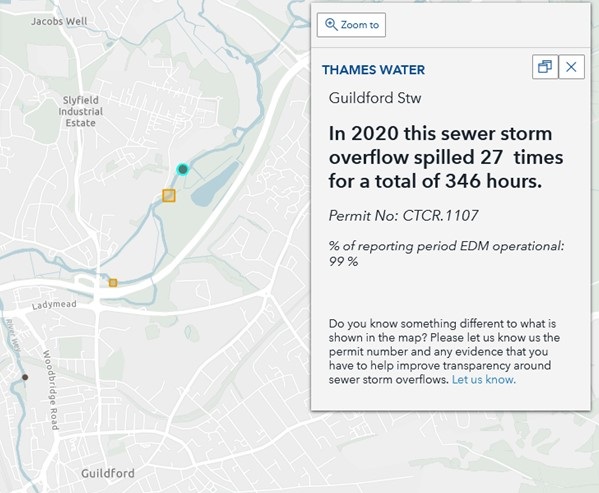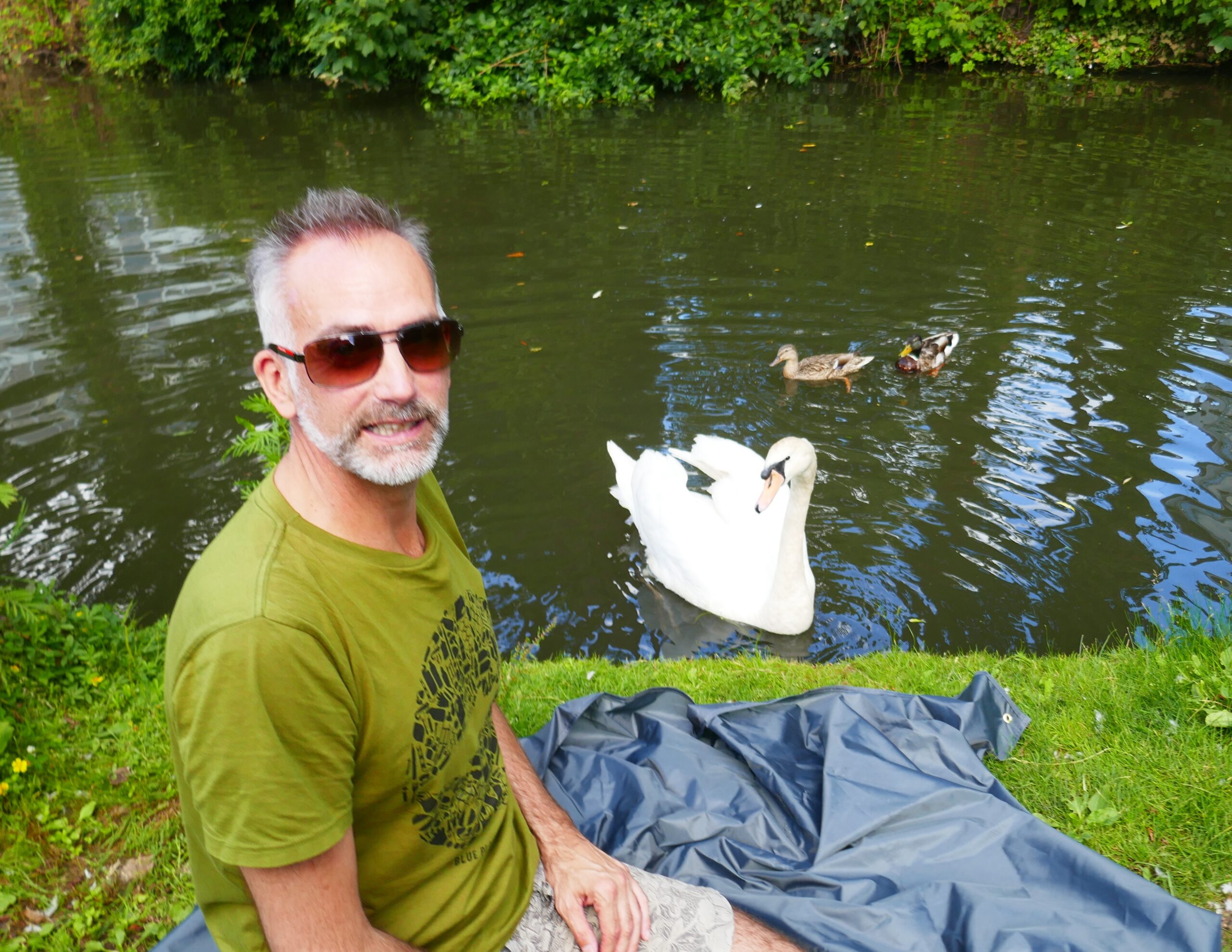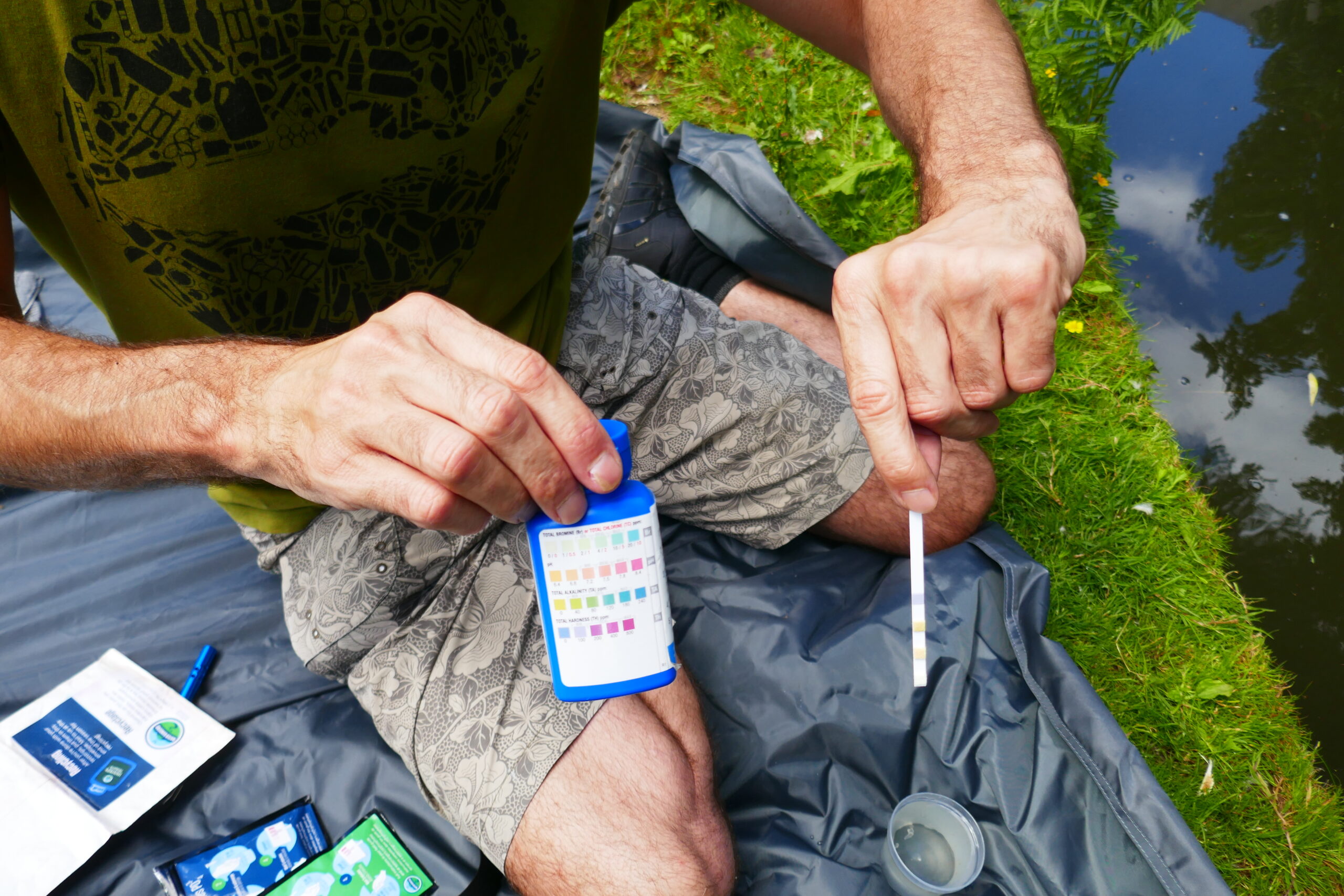 Abraham Lincoln
If given the truth, the people can be depended upon to meet any national crisis...
Abraham Lincoln
If given the truth, the people can be depended upon to meet any national crisis...
 Guildford news...
for Guildford people, brought to you by Guildford reporters - Guildford's own news service
Guildford news...
for Guildford people, brought to you by Guildford reporters - Guildford's own news service
Citizen Scientists Show River Wey Nitrate Levels Three Times Higher At Sewage Works
Published on: 13 Jul, 2022
Updated on: 13 Jul, 2022
By Hugh Coakley
Initial results from a programme of water quality monitoring on the River Wey by local citizen scientists show nitrate levels are three times higher downstream of the Slyfield sewage treatment works than upstream.

Some of the 20 volunteer citizen scientists who are carrying out monthly water quality tests at five locations on the River Wey around Guildford, pictured here at St Catherines. Photo from the Zero Carbon website.
This is raising eyebrows amongst the volunteers who have started carrying out monthly tests of water quality in the river because of pollution concerns.
Alan Thorogood, one of the organisers from Zero Carbon who initiated the testing programme with the River Wey Trust and Water Rangers, said: “It’s clearly coming from the sewage works. We want to find out more and know why.”
The programme of testing the water comes in the wake of concerns about water companies discharging sewage into rivers after certain weather events, such as prolonged periods of heavy rain. The Environment Bill 2021 tightens up on this by saying water companies “must secure a progressive reduction in the adverse harm” caused by sewage dumps.

Data from The Rivers Trust showing numbers of sewage storm discharges from the Thames Water outfall at the Guildford sewage treatment works (STW) at Slyfield in 2020.
But many are saying this is not enough (see Guildford’s MP Defends Government On Sewage Discharge Into Rivers).
And they have a point says Thorogood. He said: “We are in a rich borough and our river water quality is poor. Its shocking there are no rivers in the UK classified to be clean enough to swim in.
“Our aim is for our river to be cleaned up and designated as a swimming location”
The monthly monitoring at five sites on the Wey tests for temperature, conductivity, nitrates, phosphates, chlorine, pH, alkalinity and water hardness.
The testing kits are designed to be a easy to use as possible. All materials are recyclable.
Thorogood said he likes the term “citizen scientist” as it “accurately describes what we are doing but it’s fun as well”.
They have around 20 volunteers now but they want more so they can test more sites. “If you have a location you think should be tested, please tell us” he said.
They have three months results so far but they want to build up a six month database so they can engage with the water authorities to pressure them for improvements.
“We are arranging for a tour of the Slyfield sewage works to understand more. We want to be involved in the consultation on the new Guildford sewage works so we have to start talking with them now.”
He said people are concerned about the water quality on the river. “When we test, we always get passers by chatting and asking us what we are doing. They always have their tale about the water quality and most people are worried, especially the anglers, kayakers, rowers and swimmers.
“If you want to help, we will give you full training in what to do. Contact us at info@zerocarbonguildford.org and ask to be linked up with the team. We would love to have you join in with this fascinating work.”
We have contacted Thames Water for a comment.
Responses to Citizen Scientists Show River Wey Nitrate Levels Three Times Higher At Sewage Works
Leave a Comment Cancel reply
Please see our comments policy. All comments are moderated and may take time to appear. Full names, or at least initial and surname, must be given.Recent Articles
- Dragon Review – Sherlock Holmes: The Hunt for Moriarty – Yvonne Arnnaud Theatre
- Delays to Report on Housing Revenue Account Scandal Criticised by Scrutiny Committee
- Notice: German Mini Christmas Market – November 30
- Police Smashed Roofing Scam After Rogue Workers Got Away With Thousands
- Story of ‘Jessie’s Seat’ Topiary Railway Memorial to a Guard Killed at this Spot near Chilworth
- Birdwatcher’s Diary No. 339
- Tongham and Normandy Are Both Facing a Possible Housing Boom
- Dragon Review: Buddy – The Buddy Holly Story – Yvonne Arnaud Theatre
- Good Design Rewarded – Co-Living Development Scoops Overall Winner Prize
- Challengers Get Set To Launch Their Big Christmas Campaign



Recent Comments
- roger kendall on Birdwatcher’s Diary No. 339
- Robert Jennings on Memories Of Queen Elizabeth Barracks And The Women’s Royal Army Corps
- Julie Howarth on Biddles – A Guildford Business for 140 Years Today
- RWL Davies on No Promise of A Mayor for Surrey
- John S Green on ‘Disaster in the Making’: Residents React with Anger and Distrust
- Amari Hawthorne-Bailey on Memories Of Queen Elizabeth Barracks And The Women’s Royal Army Corps
Search in Site
Media Gallery
Cllr Townsend on Waverley’s CIL Issue
August 27, 2025 / Comments Off on Cllr Townsend on Waverley’s CIL Issue / Read MoreMP Zöe Franklin Reviews Topical Issues
August 27, 2025 / Comments Off on MP Zöe Franklin Reviews Topical Issues / Read MoreMP Hopes Thames Water Fine Will Be ‘Final Nail in Its Coffin’
August 27, 2025 / Comments Off on MP Hopes Thames Water Fine Will Be ‘Final Nail in Its Coffin’ / Read MoreNew Guildford Mayor Howard Smith
August 27, 2025 / Comments Off on New Guildford Mayor Howard Smith / Read MoreA New Scene for a Guildford Street
August 27, 2025 / Comments Off on A New Scene for a Guildford Street / Read MoreDragon Interview: Sir Jeremy Hunt MP on His Knighthood and Some Local Issues
August 27, 2025 / Comments Off on Dragon Interview: Sir Jeremy Hunt MP on His Knighthood and Some Local Issues / Read MoreDragon Interview: Paul Follows Admits He Should Not Have Used the Word ‘Skewed’
August 27, 2025 / Comments Off on Dragon Interview: Paul Follows Admits He Should Not Have Used the Word ‘Skewed’ / Read MoreDragon Interview: Will Forster MP On His Recent Visit to Ukraine
August 27, 2025 / No Comment / Read MoreDragon Interview: Fiona Davidson on the ‘Devolution’ Proposals for Surrey
August 27, 2025 / No Comment / Read More












William Lawrence
July 14, 2022 at 8:04 am
Will the new sewerage plant make a difference and is there any pollution from the landfill at the same place? Also, will the new development, the Weyside urban village affect these levels?
Sam Peters
July 14, 2022 at 8:41 am
We are now also monitoring the Wey in various locations in Godalming, as well as the Tillingbourne in Abinger Hammer and Gomshall, with plans to expand our network further as resources and volunteers allow.
It is shameful that the Wey continues to be in the top 25 per cent of the most polluted rivers in the country, failing on four out of 16 chemical contaminant measures including two deemed “Priority Hazardous”.
Hopefully, this information will allow us to hold those responsible to account and make it impossible for our politicians to ignore or sweep the issue under the rug any longer.
Sam Peters is a former Green Party candidate in local elections
Jim Allen
July 14, 2022 at 8:55 am
This is absolutely no surprise. The registered capacity is 89,810 population equivalent (PE) (2018) while the “paperwork” for the new sewage treatment works (STW) states 92,900 PE being currently treated. And in simple terms will be 18 per cent under capacity by 2027 when and if the new STW is built.
The new STW planning permission is not up before the GBC Planning Committee until September 2022 with many unanswered questions regarding leachate, bank stability and pollution from the new site
It is time reality is accepted; moving the STW is irrational and environmentally damaging. The “old” STW needs rapidly upgrading to meet future demands.
Tim Hoban
July 14, 2022 at 2:35 pm
Ok, 3x more nitrates downstream, but that is meaningless without an absolute value to compare with “good quality” water.
Additionally, the main issue with sewage is its impact on dissolved Oxygen – the reduction of which, has a catastrophic impact on both vertebrate and invertebrate life in the river.
The standard would be to test for Biological Oxygen Demand. If this is too expensive/infeasible then sampling the fauna and scoring against a biotic index would give a good view of river health. That would be a great job for volunteers.